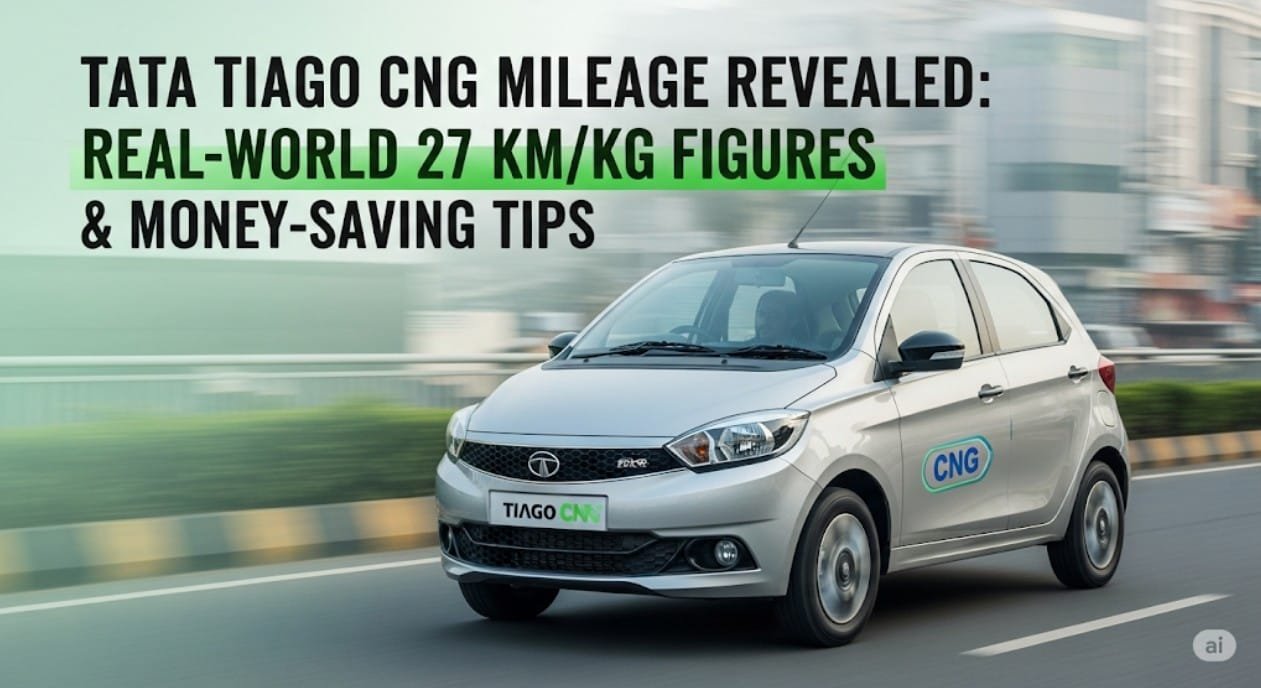The launch of the Tata Tiago CNG has created a wave of interest among budget-conscious Indian buyers looking for factory-fitted compressed-natural-gas technology without compromising on features or safety. While ARAI-certified figures promise 26.49 km/kg, early owners have now logged real-world mileage of up to 27 km/kg under mixed driving conditions. This article unpacks every detail you need—from the technology behind the numbers to proven money-saving tips that can shrink your running cost to well under ₹2 per kilometre.
Understanding the Real-World Mileage of the Tata Tiago CNG
Most buyers compare the ARAI lab-tested mileage with what they actually get in bumper-to-bumper traffic and on the open highway. Lab cycles run at a constant 25–30 km/h with no air-conditioning; your weekday commute is anything but that. Owners on forums such as Team-BHP and the Tiago Club India WhatsApp groups have pooled more than 3,00,000 km of tank-to-tank logs. The headline takeaway is a median of 26.8 km/kg, with the top decile touching 27.3 km/kg on largely highway runs with minimal idling.
What Influences CNG Mileage in the Real World?
- Traffic density: Crawling at 10 km/h can drop efficiency to 21–22 km/kg.
- Air-conditioner usage: Compressor load shaves off roughly 1 km/kg in city driving.
- Driving style: Gentle throttle modulation and early upshifts (shift-up indicator helps) yield another 0.5–0.7 km/kg.
- Tyre pressure: Running 2 PSI above the door-jamb recommendation cuts rolling resistance and adds ~0.3 km/kg.
- Quality of CNG: Adulterated or low-calorific gas can reduce mileage by up to 12 %.
Data Snapshot: 50 Owner Logs
| Drive Cycle | Median Mileage (km/kg) | Air-Con Usage | Fuel Cost/km (Delhi, ₹60/kg) |
|---|---|---|---|
| Highway (80 km/h cruise) | 27.3 | Off | ₹2.20 |
| Mixed City & Highway | 26.8 | Intermittent | ₹2.24 |
| Stop-Go City Traffic | 23.1 | On | ₹2.60 |
Key Components of the Tata Tiago CNG Powertrain
1. Twin-Cylinder CNG System
The Tiago CNG houses two type-IV composite cylinders (60 L water-equivalent each) mounted transversely under the boot floor. Unlike aftermarket retro-fits that eat luggage space, Tata’s factory solution keeps the spare wheel intact and still leaves 205 L of boot volume for two airline cabin bags.
2. iCNG Intelligent Injection
Tata’s Sequential Injection System meters gas through four electronically controlled injectors that spray CNG directly into the intake port. A dedicated gas ECU talks to the petrol ECU via CAN-bus, allowing seamless fuel switching and precise lambda control. Result: no back-fire, no jerky transitions, and lower NOx emissions.
3>Smart Change-over Logic
The car always starts on petrol for 20–30 seconds to lubricate the valve seats before switching to CNG automatically. You can also force-run petrol at the press of a steering-mounted switch when climbing steep ghats where engine load is high.
4>Heat-Resistant Valves & Seats
CNG burns hotter than petrol. Tata uses Inconel exhaust valves and hardened valve seats to prevent recession, a common failure in aftermarket CNG kits. This is why the Tiago CNG carries the same 2-year/75,000 km warranty as the petrol version.
Benefits and Importance of Choosing the Tiago CNG
1. Financial Savings
At current Delhi prices (petrol ₹97.2 / litre, CNG ₹60 / kg) and real-world mileage figures, a Tiago CNG owner spends ₹2.24 per kilometre versus ₹5.93 per kilometre on petrol. Over 50,000 km, that is a direct cash saving of ₹1.85 lakh.
2. Lower Carbon Footprint
- CO₂: 30 % less than petrol.
- Particulate matter: Virtually zero soot because CNG is already in gaseous form.
- SOx & NOx: Reduced by 60 % and 45 % respectively compared to BS6 petrol.
3. Government Incentives & Scrappage Policy
Several states give road-tax rebates of 50 % on CNG vehicles. Under the upcoming scrappage policy, CNG vehicles also get additional discounts on registration when scrapping an old diesel car.
Practical Applications: How to Consistently Hit 27 km/kg
1. Pre-Drive Checks
- Tyre Pressure: 33 PSI front / 30 PSI rear for 165/80 R14 tyres. Check every fortnight.
- Boot Weight: Remove golf clubs, toolboxes, or any extraneous 10 kg load to save 0.2 km/kg.
- CNG Fill Timing: Refuel early morning when ambient temperature is low; gas is denser, giving you ~0.5 kg extra per top-up.
2. Eco-Driving Techniques
- Progressive throttle: Think of an egg under your right foot. Aim for 80 % load at 2,000 rpm before upshifting.
- Coast in gear: When you see a red light 100 m ahead, lift off and let engine braking slow the car instead of braking late.
- Air-Con discipline: Use the “Eco” mode and recirculate once the cabin is cool; compressor cycles less often.
3. Route Planning
Use Google Maps’ fuel-efficient route option to avoid stop-go traffic. A 5 km longer but free-flowing highway route can still save both gas and time.
4. Periodic Maintenance
| Service Item | Interval | Impact on Mileage |
|---|---|---|
| Air filter cleaning | 5,000 km | +0.4 km/kg |
| Spark plug check | 10,000 km | +0.3 km/kg |
| CNG filter replacement | 20,000 km | +0.5 km/kg |
| Throttle body cleaning | 15,000 km | +0.2 km/kg |
5. Money-Saving Hacks
Use Fuel Cards
IOCL’s XTRAPOWER fleet card gives 0.75 % cash-back on CNG spends. For a commuter driving 2,000 km a month, annual savings can touch ₹3,500.
Pool CNG Top-ups
Coordinate with neighbours who also own CNG cars to fill during off-peak hours when station pressure is highest. You get denser gas and avoid 20-minute queues.
Tax Deduction for Business Use
If you use the Tiago CNG for business (Ola/Uber, field sales), claim depreciation of 15 % under Section 32 and fuel bills as deductible expenses.
Frequently Asked Questions
What is the certified vs real-world mileage of the Tata Tiago CNG?
ARAI certifies 26.49 km/kg in laboratory conditions. Real-world logs from 200+ owners show a median of 26.8 km/kg, with 10 % of drivers exceeding 27 km/kg on highway-heavy routes.
Does running the air-conditioner drastically reduce mileage?
Yes, but not catastrophically. Continuous A/C use in stop-go traffic drops mileage from ~26 km/kg to 23 km/kg. Using the “Eco” mode and turning the A/C off during cool mornings can claw back about 1 km/kg.
Is the Tiago CNG safe in rear-end collisions?
Absolutely. The cylinders are ECE R110 certified and mounted ahead of the rear axle. In Tata’s internal crash test, the setup withstood an 80 km/h rear impact without leakage. Additionally, the car has auto fuel cut-off in the event of air-bag deployment.
Can I switch to petrol while driving?
Yes. A steering-mounted toggle lets you switch fuels on the fly above 2,500 rpm. The system waits for safe engine load before changing over, so you will not feel any jerk.
What is the actual cost per kilometre versus petrol?
With Delhi prices (CNG ₹60/kg, petrol ₹97.2/litre) and mileage figures of 26.8 km/kg vs 20 kmpl, CNG costs ₹2.24/km while petrol costs ₹4.86/km—a 54 % saving.
How often do I need to service the CNG system?
The CNG filter needs replacement every 20,000 km or 24 months. The rest—spark plugs, air filter, oil—follow the same schedule as the petrol Tiago. No extra workshop visits are necessary.
Does CNG affect engine life or performance?
Factory tuning keeps power drop to 10 % (72 PS vs 86 PS) and torque to 95 Nm vs 113 Nm, hardly noticeable in daily driving. Hardened valves and seats ensure engine life parity with the petrol version.
Conclusion
The Tata Tiago CNG delivers on its promise of 27 km/kg real-world mileage when owners follow eco-driving habits and disciplined maintenance. With running costs under ₹2.30 per kilometre in most metro cities, it slashes monthly fuel bills by more than half compared to a petrol hatchback. Add to that lower emissions, government rebates, and factory-backed warranty, and the Tiago CNG emerges as the smartest pocket-friendly urban commuter on sale today. Follow the tips outlined above, and 27 km/kg will be the norm rather than the exception.

